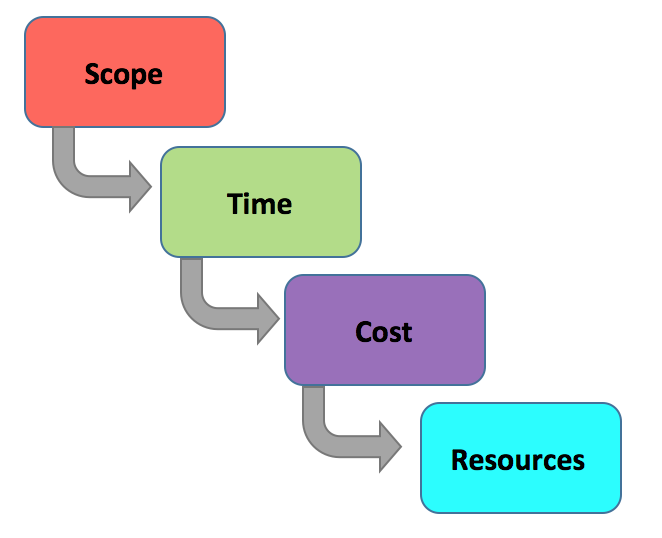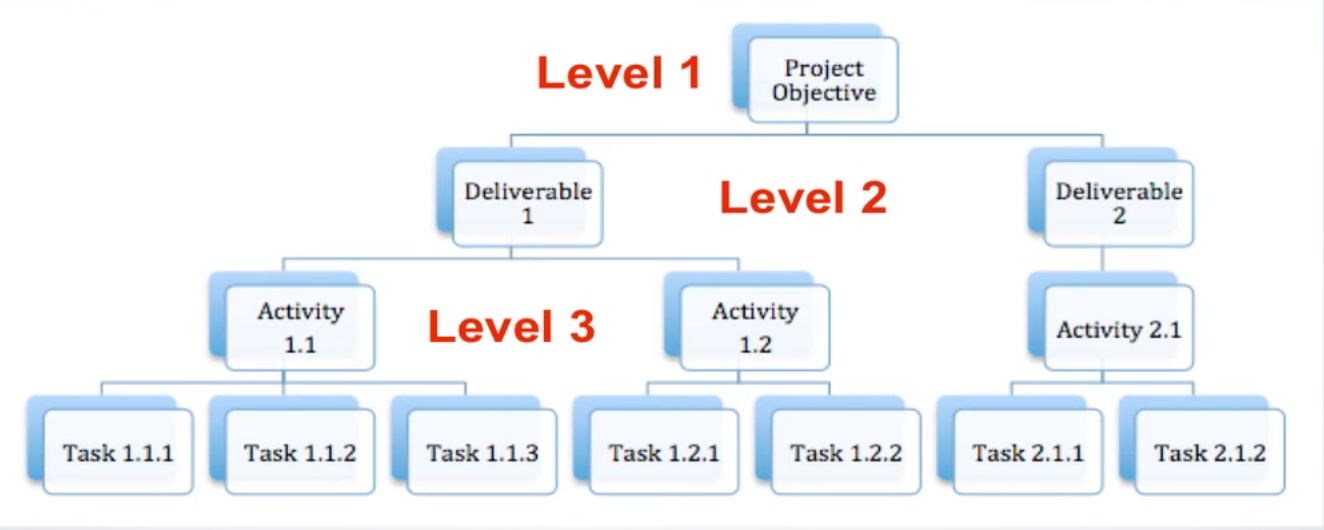The work breakdown structure in project management
The work breakdown structure (WBS) were first used by the U.S. Department of Defense for the development of missile systems in the mid- 1960s. WBS was initially developed by the U.S. Department of Defense (DoD) and the National Aeronautics and Space Administration (NASA) for the purpose of planning and controlling large acquisition projects . Today, WBS is a modern management technique, which may determine the success of a project in an organization. The approach of WBS allows the project team to visually see the work that is needed in order to complete a project. It is defined as being a deliverable- oriented hierarchical decomposition of the work to be executed by the project team to accomplish the project objectives and create the required deliverables. Furthermore, WBS can prove pivotal within project management planning processes by partitioning projects into stages, deliverables and work packages. If the management tool is used correctly, it can have a positive impact on other project management processes, such as activity definition, project schedule, risk analysis and response, control tools or project organization. Moreover, the WBS do not only help the project team to scope the work into deliverables but do also look into activities and tasks required to complete a project. WBS is essential since It reduces the number of surprises and furthermore, improves the ability to manage future projects in an organization.
Contents |
Why is work breakdown structure important?
Project management includes identifying requirements of the project, establishing clear and achievable objectives, balancing the competing demands from the different stakeholders in the organization and ensuring that a commonality of purpose is achieved for the project. Today, many projects involve large- scale planning that effects the different departments in an organization. This is why planning is seen as being an essential part of the process. When using WBS it will become the backbone of the project of an organization. The management tool forms a consistent basis of a project by setting up deliverables, which are able to be managed, delegated and controlled by the project manager. The management tool helps the team defining the scope of the work needed in order to set up the project objectives. Furthermore, a broad execution strategy will help defining the main deliverables. To avoid losing the overview of “why are we doing this project?” the management tool helps identifying the deliverables and thereby, helping the team to organize and define the scope. Furthermore, the WBS helps the project team with the following:
• WBS helps the project team reducing the risk of missing important tasks and work during the project period. • WBS helps the project team subdividing the project into smaller work packages. This helps the project team to easily manage the tasks and to have a better overview of the milestones which need identification during the project period. • WBS helps engaging the project team when using the management tool. This is due to that the teams are forced to each share their knowledge within their field in order to develop the WBS. Furthermore, it gives an overview of the ambiguities and uncertainty within the project and helps clarifying both incorrect and correct assumptions. WBS is a good tool when narrowing and defining the scope and furthermore, raises the important issues of the project in an early stage. The high-level of participation of the project team and the clarification when preparing the WBS helps structuring and well- define the tasks, allow the resources to be assigned to specific tasks, and furthermore, it creates accountability and commitment among the project team members.
The work breakdown structure
To get an understanding of the hierarchy of the WBS it is important to understand  the main structure of the management tool. When setting up the model it is modeled
after four different areas. Scope, Time, Cost and Resources.
the main structure of the management tool. When setting up the model it is modeled
after four different areas. Scope, Time, Cost and Resources.
Structure of the WBS Definition Illustrations
Scope The scope is defined as the broad strategy of the project which is planned. The scope is an important step of the process when developing the WBS since it determines a list of specific projects goals, objectives, main deliverables, tasks, cost and the deadline.
Time An accurate time estimation is a skill essential for good project management. The time estimation drives the setting of the deadline for the deliverables and the planning process of the project. Furthermore, in this step a WBS dictionary is created. The WBS dictionary includes entries for each WBS component that briefly defines the scope or the statement of the work (SOW) which is a document that defines project- specific activities, deliverables and timelines. Furthermore, the SOW typically also includes detailed requirements and pricing.
Cost Cost is an essential part when planning a project. The cost within WBS involves budgeting and an integrated earned value management system (EVMS) also known as Earned value management (EVM). EVM is a project management technique for measuring the project performance and progress. EVM has the ability to combine measurements of the project management triangle which includes scope, time and costs. Furthermore, EVM is able to provide accurate forecasts of project performance problems.
an illustration of earned value management
Resources The last step of the WBS is identifying the resources within the project. The resources are determined by using the responsibility matrix. The responsibility matrix is used to define who in the organization is responsible for individual work elements and deliverables during the project period. The responsible matrix is divided into the following categories
R – Responsible A – Accountable C – Consult I – Inform
an illustration of the responsible matrix
After an explanation of the main structure it is now possible to demonstrate how a work breakdown structure is conducted in a project team.
The work breakdown structure hierarchy
The PMBOK® Guide – Fourth Edition, defines the Work Breakdown structure as “a deliverable- oriented hierarchical decomposition of the work to be executed by the project team to accomplish the project objectives and create the required deliverables”. As earlier mentioned WBS consists of Work packages which are defined in two different ways in the PMBOK Guide – Fourth Edition. The first definition of the work package is said to be the “lowest level in the WBS, and is the point at which the cost and schedule can be reliably estimated. The level of the WBS will vary depending on the complexity of the project. It is important to know that the WBS is a repeatable process that can be used as a template for future projects.
WBS should begin in two stages. The first stage is to hold a team meeting. The teams meeting consists of that the member begins planning the first hierarchy level and furthermore, makes the project title. After this has been done the second level of the hierarchy begins. The second level in the WBS hierarchy stage contains descriptive details of all the deliverables that needs to be performed in order to complete the project and determine the timeline of the project. It is important that everything within the scope statement and the project plan is defined before starting the project. When the first and the second level is set, a decomposition and a breakdown of the deliverables of the project and its timeline can begin. The deliverables, which is attached in a tree form to the hierarchy are considered work packages. It is important that the work packages are constantly reviewed and monitored by the project manager and given a timeline upfront. The work packages are completed by different team members, which produce the deliverables which eventually fulfills the different phases in the project. The book The PMBOK® Guide – Fourth Edition suggests that a work package should not be less than eight hours but no more than eight hours.
 an illustration of the different level in the WBS hierarchy
an illustration of the different level in the WBS hierarchy
Examples of a WBS
(WIP) Bla bla bla During this article two key points has been highlighted when building a WBS.
1. Define the scope of work. The scope definition should include; the project objectives which is allocated at the top of the WBS tree and the execution strategy for the project. 2. Broad execution strategy should be divided into main deliverables since it will form the backbone of the project and furthermore be the structure which the project will rely on during the project period.
an illustration of a work breakdown structure
Reflections on the use of WBS
During the analysis of the articles used for this article it has shown that there are both pros and cons when using the WBS. Even though, that the WBS is known as being the fundamental building block for most projects, there are still many conflicting viewpoints when developing and approaching the WBS. The table below shows some of the pros and cons associated with using the WBS.
Pros Cons • WBS lays the ground work for accurate project costing. This is due to that the management tool carries out bottom-up project costing and estimating which is the most accurate estimating method. • If the scope of the project isn’t defined the WBS cannot be used. • WBS gives an accurate project schedule which includes all tasks which is needed to complete the project in time and furthermore, meeting the delivery dates. • A poorly constructed WBS can result in a negative project outcomes including ongoing, repeated project re-plans and extensions, unclear work assignments for project participants, unmanageable, frequently changing scope, as well as budget overruns, missed deadlines and ultimately unusable new products or delivered features that do not satisfy the customer nor the objectives for which the project was initiated
Work breakdown structure video
The video below is a guide for how to build a work breakdown structure. Furthermore, the video illustrates the different views on Timelines, Gantt chart, and mind map.
Annotations
WIP http://smallbusiness.chron.com/important-organizations-use-project-management-46723.html http://www.managementstudyguide.com/project-management-importance.htm http://www.brighthubpm.com/project-planning/38696-the-importance-of-defining-a-projects-duration/ http://www.workbreakdownstructure.com/work-breakdown-structure-according-to-pmbok.php http://site.ebrary.com/lib/aalborguniv/reader.action?docID=10518778 http://projectplanonline.com/pmo-products/ http://2020projectmanagement.com/2013/10/the-responsibility-assignment-matrix-ram/ http://www.workbreakdownstructure.com/work-breakdown-structure-according-to-pmbok.php http://www.pmis-consulting.com/articles/earned-value-management/